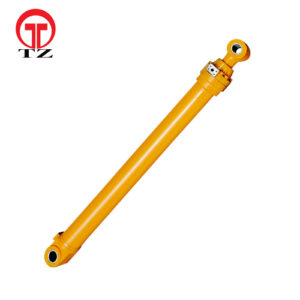The hydraulic cylinder in an excavator is typically connected to the boom and arm through a combination of mounting brackets, pins, and pivot points.
Here’s a general overview of how the hydraulic cylinder is connected to the excavator’s boom and arm:
Mounting Brackets: The hydraulic cylinder is attached to the excavator’s boom and arm through mounting brackets. These brackets are specifically designed to secure and support the cylinder in its proper position.
Cylinder Rod End Connection: One end of the hydraulic cylinder, known as the rod end, is connected to the boom or arm using a pin or a clevis attachment. The pin is inserted through the mounting bracket and the rod end of the cylinder, holding them together and allowing for movement.
Cylinder Head End Connection: The other end of the hydraulic cylinder, known as the head end, is connected to the opposite component (boom or arm) using a similar pin or clevis attachment. This connection allows the cylinder to extend and retract, providing the desired motion for the excavator’s operation.
Pivot Points: The boom and arm of the excavator are designed with pivot points that allow for rotation and movement. hydraulic cylinder for excavator These pivot points are typically located near the connection points of the hydraulic cylinder. The cylinder’s movement is facilitated by the rotation of these pivot points, enabling the boom and arm to extend, retract, and articulate.
Hydraulic Hoses: Hydraulic hoses are used to supply pressurized hydraulic fluid to the hydraulic cylinder. These hoses connect the cylinder to the excavator’s hydraulic system, allowing for the transmission of hydraulic power and control signals.
It’s important to note that the specific configuration and connection methods may vary depending on the excavator model and manufacturer. Additionally, proper alignment and secure attachment of the hydraulic cylinder are critical to ensure safe and efficient operation of the excavator.
What are the common maintenance procedures for hydraulic cylinders in excavators?
Regular maintenance of hydraulic cylinders in excavators is essential to ensure their optimal performance and longevity.
Here are some common maintenance procedures for hydraulic cylinders:
Visual Inspection: Regularly inspect the hydraulic cylinder for any visible signs of damage, such as leaks, dents, or corrosion. Check for loose or damaged mounting brackets, pins, or pivot points. Look for any signs of wear or degradation in the cylinder rod, seals, or wipers.
Fluid Inspection: Monitor the hydraulic fluid levels and check for any signs of contamination, such as the presence of water, dirt, or debris. If the fluid appears discolored or contaminated, it may need to be drained and replaced.
Seal and Wiper Inspection: Examine the piston seals, rod seals, and wipers for signs of wear, damage, or leakage. Replace any worn or damaged seals promptly to prevent fluid leaks and maintain the cylinder’s performance.
Lubrication: Ensure that all moving parts of the hydraulic cylinder, including the rod and pivot points, are properly lubricated. Follow the manufacturer’s recommendations for the type and frequency of lubrication.
Cylinder Rod Maintenance: Keep the cylinder rod clean and free of debris. If there are any scratches or nicks on the rod surface, they should be carefully smoothed out to prevent damage to the seals and wipers.
Pressure Testing: Periodically perform pressure testing to assess the hydraulic cylinder’s performance and detect any potential issues. This involves pressurizing the cylinder to its operating pressure and checking for leaks or abnormal behavior.
System Flushing: If there has been contamination or a major repair, it may be necessary to flush the hydraulic system to remove any remaining contaminants. Flushing involves circulating clean hydraulic fluid through the system to remove dirt, debris, or old fluid.
Cylinder Rebuilding or Repair: If a hydraulic cylinder exhibits significant wear or damage, it may need to be rebuilt or repaired. This involves disassembling the cylinder, replacing worn components, and reassembling it with new seals, wipers, and other necessary parts.
Regular Service Schedule: Adhere to the manufacturer’s recommended service schedule for the hydraulic system and the excavator as a whole. This includes fluid changes, filter replacements, and other routine maintenance tasks.
Documentation: Keep records of all maintenance and repairs performed on the hydraulic cylinder. This helps track the cylinder’s history, identify recurring issues, and ensure that maintenance is performed on time.
It’s important to consult the excavator’s operation and maintenance manual for specific maintenance guidelines and recommendations. Additionally, following proper safety procedures and working with trained technicians is crucial when performing maintenance on hydraulic cylinders in excavators.
